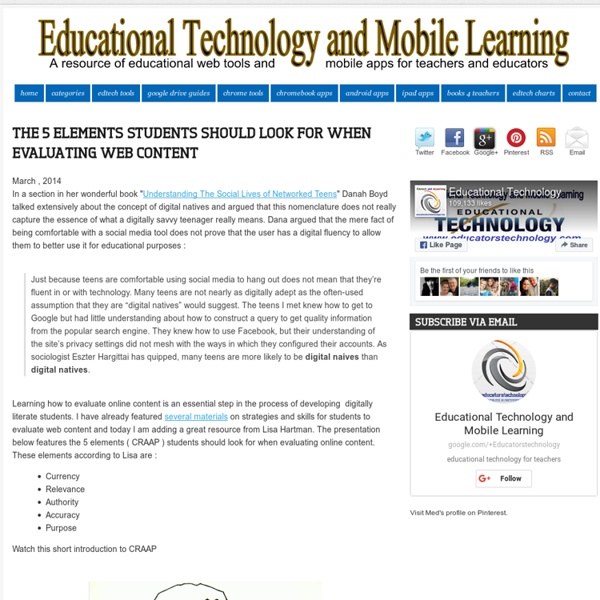Evaluating internet information
Information comes to us from a wide variety of sources. Can you tell good information from bad? MajesticSEO's Fresh Index estimates that there are almost 700 billion web pages out there and that search engines cover less than 1/4 of that! (what percent of this do you think will be QUALITY, USEFUL information?) Here are some things to remember when you use the Web:
The Credibility Challenge
Summary The Internet can be a rich and valuable source of information – and an even richer source of misinformation. Sorting out the valuable claims from the worthless ones is tricky, since at first glance a Web site written by an expert can look a lot like one written by your next-door neighbor. This lesson offers students background and practice in determining authority on the Internet – how to tell whether an author has expertise or not, and whether you’re getting the straight story. Objectives
It's Fake???
There are four broad categories of fake news, according to media professor Melissa Zimdars of Merrimack College. CATEGORY 1: Fake, false, or regularly misleading websites that are shared on Facebook and social media. Some of these websites may rely on “outrage” by using distorted headlines and decontextualized or dubious information in order to generate likes, shares, and profits.
E.S.C.A.P.E. Junk News
GRADE LEVEL: Middle and high school TIME: 30-60 minutes MATERIALS: E.S.C.A.P.E. Junk News poster (download), E.S.C.A.P.E.: Six Key Concepts worksheets (download), a news story for students to evaluate, internet access
Digital Credibility: 13 Lessons For the Google Generation -
13 Digital Research Tools And The Credibility Lessons They Teach by TeachThought Staff This post is promoted by Noet, makers of Encyclopedia Britannica Noet Edition and the free research app for the classics, who asked us to talk about the credibility of information research in a digital world. We thought, then, that it might make sense to focus on digital tools and resources that highlight the idea of credibility. And because credibility and research are such important digital concepts–or really, data and thinking concepts, actually–we itemized each tool as lesson in and of itself. The Google Generation has a universe of information, right there on a little pinch-and-zoom screen.
Why Teachers Should Use Education Technology
How do you respond to someone when they ask you WHY they should use education technology? Do you get flustered and attempt to walk them through an array of apps and web tools that can help them save time, reduce friction in the classroom, and more? If you’re an Edudemic reader, then you probably already use edtech and are happy to walk others through those exact points. But what happens when you need a bit of a refresher?
Keep it REAL–4 Easy Steps to Determine Source Credibility
The problem: Not all sources are created equal. The solution: Keep it REAL–4 Easy Steps to credible & authentic source material. When it comes time to do research, most of us (not *just our students), reach for our phones and just “Google it.” Yet, when it comes time to incorporate source content into their writing, we want students to go beyond that one easy step. Our students have an enormous amount of information at their fingertips.
Is This Story Share-Worthy? Flowchart - NewseumED
GRADE LEVEL: Middle and high school TIME: 30-60 minutes MATERIALS: Is This Story Share-Worthy? flowchart, either printed on large paper or available to view on a screen(s) (download); Is This Story Share-Worthy? worksheet, one per group (download); news stories for students to evaluate (at least one per group); internet access Review the Is This Story Share-Worthy?
Teaher's Guide to Information Crap Detection
Information overload, information crap,information pollution...are some of the words that are being used now to describe the tsunami of irrelevant information we are bombarded with day and night.In December 2009, Google began customizing its search results for all users, and we entered a new era of personalization. With little notice or fanfare, our online experience is changing, as the websites we visit are increasingly tailoring themselves to us.Everywhere you turn you find information that seems relevant to you but in fact is nothing but crap. This is probably why Eli Pariser recommended what he called Information Bubble.
EdTech Cheat Sheet
Understanding New Trends in Educational Technology Trying to keep up with all of the new buzzwords in the booming Educational Technology sector can leave you feeling like a kindergartner in a calculus class. Don't tell your teach, but we put together a little cheat sheet to keep you informed on what's happening inside and outside of today's most innovative schools. Think we're missing any major terms or trends? Let us know on Twitter.
Checklist for Evaluating Web Resources
Is the Web a good research tool? This question is dependent on the researcher's objective. As in traditional print resources one must use a method of critical analysis to determine its value.
50 Activities To Promote Digital Media Literacy In Students
Literacy is changing–not at its core necessarily, but certainly at its edges as it expands to include new kinds of “reading.” Digital media is quickly replacing traditional media forms as those most accessible to most 21st century learners. The impact of this change is extraordinarily broad, but for now we’ll narrow it down to changes in how learners respond to the media they consume. The most fundamental pattern of formal academia is to read something and then write about it. Sometimes this writing comes in the form of responding to questions, while other time it’s in the form of an essay. And sometimes the reading is watching, playing with, or otherwise interacting with a digital media.



